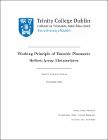| dc.contributor.author | Pelivani, Sara | |
| dc.date.accessioned | 2021-11-11T15:02:22Z | |
| dc.date.available | 2021-11-11T15:02:22Z | |
| dc.date.issued | 2021 | en |
| dc.date.submitted | 2021 | |
| dc.identifier.citation | Pelivani, Sara, Working Principle of Tunable PlasmonicReflect-Array Metasurfaces, Trinity College Dublin.School of Physics, 2021 | en |
| dc.identifier.other | Y | en |
| dc.identifier.uri | http://hdl.handle.net/2262/97531 | |
| dc.description | APPROVED | en |
| dc.description.abstract | This thesis will explore the way in which plasmonic metasurfaces, hosting nano-scale metallic resonator elements, can be used as beam-steering devices. We will propose our own devices that will demonstrate anomalous reflection (at a pre-determined reflection angle), despite being illuminated by normal incident light. The performance of these devices will be investigated in the near-infrared region of the spectrum, though their working principle is not limited to such a narrow wavelength range. Through the incorporation of a phase-change-material, our devices will be able to support dynamic control over the reflected radiation post-fabrication. Different methods of achieving this control over the propagation path of scattered radiation are explored and compared. I.e. anomalous reflection is shown to be realised by varying the geometry of the resonator element along the device surface, varying the local environment surrounding each resonator element, or both of these variations in unison.
All metasurface devices presented in this work will employ a metal-insulator-metal structure. Therefore, our first objective was to optimise the performance of such a device by conducting a comparative study between three difference Drude-like metals (gold, silver, and aluminium). Through this study, the ideal material (and material properties) of the top metallic resonator element and bottom back-reflector could be determined. The ideal resonator element material was found to be gold and silver, while the ideal back-reflector material was found to be aluminium. The performance of a device which employed this combination of materials was presented, exhibiting a maximum anomalous reflection angle of ~ 40° at an incident wavelength of 1550 nm. This device used variations in the geometry of the resonator elements in order to achieve the impressive anomalous reflection.
The performance of an alternative device is also reported. This device utilises variations in the local environment surrounding each resonator element, and is capable of achieving the largest dynamic angle sweep of ~ 54° at an incident wavelength of 1000 nm. A device which employes both of these methods to achieve anomalous reflection is also proposed. Such a device is shown to be able to achieve an anomalous reflection angle of ~ 33° also at an incident wavelength of 1000 nm.
The advantages, disadvantages, and extent to which each device can achieve dynamic control over the reflected radiation post-fabrication is discussed. | en |
| dc.language.iso | en | en |
| dc.publisher | Trinity College Dublin. School of Physics. Discipline of Physics | en |
| dc.rights | Y | en |
| dc.subject | Dynamically tunable beam-steering | en |
| dc.subject | Phase shift | en |
| dc.subject | Vanadium Dioxide | en |
| dc.subject | Nanophotonics | en |
| dc.subject | Multilayer design | en |
| dc.subject | Metamaterial | en |
| dc.subject | Surface-plasmons | en |
| dc.subject | Anomalous reflection | en |
| dc.subject | Metasurface | en |
| dc.subject | Specular reflection | en |
| dc.subject | Subwavelength structure | en |
| dc.subject | Phase-change material | en |
| dc.title | Working Principle of Tunable PlasmonicReflect-Array Metasurfaces | en |
| dc.type | Thesis | en |
| dc.type.supercollection | thesis_dissertations | en |
| dc.type.supercollection | refereed_publications | en |
| dc.type.qualificationlevel | Masters by Research | en |
| dc.identifier.peoplefinderurl | https://tcdlocalportal.tcd.ie/pls/EnterApex/f?p=800:71:0::::P71_USERNAME:PELIVANS | en |
| dc.identifier.rssinternalid | 234528 | en |
| dc.rights.ecaccessrights | openAccess | |
| dc.contributor.sponsor | Science Foundation Ireland (SFI) | en |
| dc.contributor.sponsorGrantNumber | 16/IA/4550 | en |




